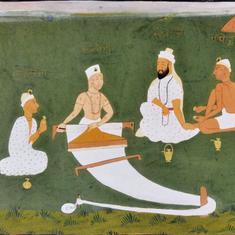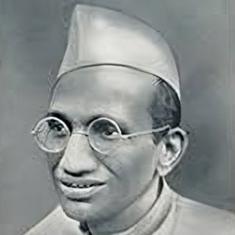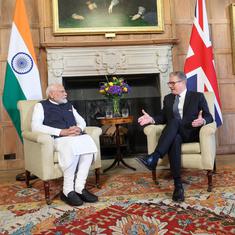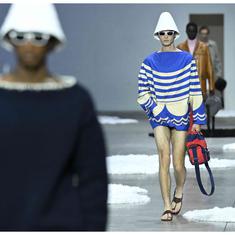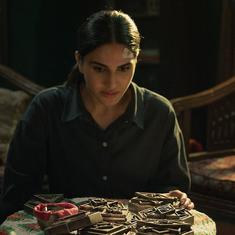“… Wargue that the cultural vibrancy of Lucknow was due to its debauched nature. Nawabi architecture materialised – in pleasure palaces, harems, and other spatial types – as a gradual adaptation of existing formal archetypes to accommodate theatricised ways of dwelling; deviant practices of power politics; gender-bending forms of dance, theatre, poetry; and performed non-normative sexuality.
The EIC targeted the nawabs’ race, gender, sexuality, physical appearance, cultural pursuits, and architectural expression – to refute the nawabs’ efficacy as political rulers – gendering the superiority and credibility of a political leader.”
When Nawab Asaf-ud-Dawla shifted the capital of Avadh from Faizabad to Lucknow in 1775, he had no idea that he and the last of his successors would turn out to be two of those rulers whom the British loved to hate. Historians still debate why Asaf shifted his capital: some say it was to get away from his mother, Bahu Begum, others that it was to establish a more prosperous city. Whatever the reason, the result was that Lucknow gained a unique culture, some of which survives in its architecture, by way of an independent style that Asaf established during the 22 years of his reign.
That style would come to an end in 1856 – the year before the Uprising of 1857 – when the East India Company (EIC) took over the kingdom, and the focal point here is that takeover, for it was done under the cleverly named Doctrine of Lapse, under which the British could decide to take over kingdoms that were either misgoverned, or had no legitimate heir to the throne. And since the Nawab of the time, Wajid Ali Shah, had a son, the British had to establish some measure of misgovernance to justify using this doctrine.
With the end of Wajid Ali’s rule also ended one of the most colourful periods of India’s colonial history. A Queer Reading of Nawabi Architecture and the Colonial Archive looks at the architecture of Lucknow during this period, particularly under the reigns of Asif and Wajid rather than the six nawabs who ruled in between them.
The queer influence
Post-Independence Indian historians have put forth substantial evidence against British claims of misgovernance by the nawabs. To quote Dr GD Bhatnagar in his book, Awadh Under Wajid Ali Shah, “Wajid Ali Shah’s character was complex. Though he was a man of pleasure, he was neither an unscrupulous knave nor a brainless libertine. He was a lovable and generous gentleman. He was a voluptuary, still he never touched wine, and though sunk in pleasure, he never missed his five daily prayers. It was the literary and artistic attainments of Wajid Ali Shah which distinguished him from his contemporaries.”
What these historians have omitted is the queer influence on the culture and architecture of Lucknow. Asaf was an accomplished Urdu poet, and in some of his work, he reveals his longing for men, a longing that the straight-laced British of his time found abhorrent. But that poetry also established the difference between the way most rulers conducted their politics and the way a queer ruler might do it.
And so, while this book might be about a queer look at architecture, it also contains a look at the power play amongst four different players towards the end of the rule of the Nawabs: on the British side are the East India Company (EIC) and the Crown, and, on the Indian, the Nawabs of Lucknow and the fading Mughal dynasty.
A queer city
To start with, the book is divided broadly into two sections, the first about methods and the second about the architecture of the buildings covered. Methods matter, because parts of the city were wiped out in the Uprising. So were some of the writings of the Nawab’s historians, and perhaps of the Nawabs themselves. The authors have followed up with many archives: the remaining Lucknow archives, the written works of these two Nawabs, archives of the East India Company and the Crown, and, of course, archives of the Government of India.
One of the more appealing illustrations here is a single chart that offers a timeline that shows Nawabs, British Residents, British Governors General, and various plans and sketches of the city, all in one, offering the reader a bird’s eye view of the history of the city.
The British archives show their contempt for the Nawabs and the queerness of their culture. The British were contemptuous of queers until well into the second half of the 20th century: witness their imprisonment of, say, Oscar Wilde in the 1890s, or their encouraging Alan Turing’s suicide in the 1960s.
Thus, some of history reflects their resistance to the British: to quote the authors, “Despite this [contempt], the two nawabs continued to hold their political position through acts of transgression, resistance, and even sometimes by playing ignorant. Both the nawabs furthered an urban cultural environment that rejected macho military standards of politics and embraced arts as central to shaping the city.”
The second section covers the actual shape of the city. Covered here in some detail are the major works of Asaf and Wajid: Asif’s architectural legacy includes the Machhi Bhavan, the Daulat Khana, and the Bada Imambada, while Wajid’s works include the Qaiserbagh, perhaps the most substantial of the precincts covered.
The descriptions are illustrated in detail, and the reconstruction of destroyed parts of these buildings is meticulous and layered, which would appeal to the architect. But what appeals to the layman and the historian in the occasional sidelight that livens up the narrative: to quote, again, “The British army was disoriented by the labyrinthine interiors of the zenana but found its flat roof quite navigable because of its continuity”.
And so, for anyone with more than a passing interest in architecture, history, or Lucknow, this book is a small treasure house and a guide to the chequered history of one of the most important cities of the British Raj.
Shashi Warrier is a novelist. His latest novel My Name is Jasmine was published by Simon and Schuster India in 2025.

A Queer Reading of Nawabi Architecture and the Colonial Archive, Sonal Mithal and Arul Paul, Routledge.

